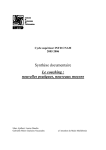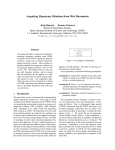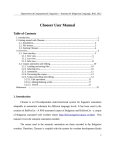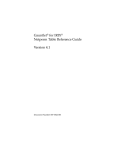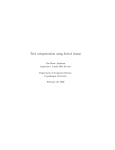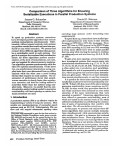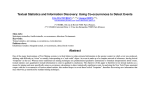Download Hydra User Manual
Transcript
Department of Computational Linguistics – Institute for Bulgarian Language, BAS, 2012
Hydra
User Manual
Table of Contents
1. Introduction........................................................................................................................2
1.1. Overview................................................................................................................2
1.2. Wordnet..................................................................................................................3
1.3. Wordnet representation in Hydra...........................................................................3
2. Getting started....................................................................................................................5
2.1. Starting Hydra........................................................................................................5
2.2. The Search window................................................................................................6
2.2.1. Search........................................................................................................6
2.2.2. Dictionary management.............................................................................7
2.3. The Dictionaries.....................................................................................................8
2.4. Synchronisation......................................................................................................9
2.4.1. Synchronisation between the wordnets and the Search window.............10
2.4.2. Synchronisation between the wordnets...................................................11
2.5. Working with the Wordnet data............................................................................13
2.5.1. Dictionary views......................................................................................13
2.5.2. Editing.....................................................................................................17
2.5.2.1. Editing an existing object............................................................17
2.5.2.1.1. General description..............................................................17
2.5.2.1.2. Operations in the Edit mode................................................19
2.5.2.2. Creating a new synset..................................................................31
2.5.2.3. Cloning a synset..........................................................................34
2.5.2.3................................................................................................................37
2.5.3. Searching in Hydra..................................................................................37
2.5.3.1. Simple search..............................................................................37
2.5.3.2. Regular expression search...........................................................38
2.5.3.3. Formula search............................................................................38
2.5.3.4. Formula query tips......................................................................41
References............................................................................................................................43
1
Department of Computational Linguistics – Institute for Bulgarian Language, BAS, 2012
1. Introduction
1.1. Overview
Hydra is an OS-independent system designed for wordnet development, validation and
exploration. It represents Wordnet as a relational structure and embeds a modal language
for searching in the wordnet data.
The wordnet data are represented as a relational database. Information retrieval and
management is handled by means of a relational database management system and SQL.
The system enables users to edit and browse any number of monolingual wordnets at a
time. It provides a user-friendly GUI with different options for data display. The
individual wordnets are synchronised, so that equivalent synsets in the different wordnets
may be viewed and explored in parallel.
An important feature of the system is the multiple-user concurrent access.
The changes made to the database are updated immediately, so that all the users are able
to access the updated data at once.
The system performs automatic data consistency and completeness verifications. The
completeness checks performed for the obligatory elements of a synset are described in
the relevant sections below. User specified validation queries are also enabled. Examples
of such queries are given in section 2.5.3.4., subsection Validation queries.
Hydra is coupled with the corpus annotation tool Chooser and has been successfully
employed in the annotation of the Bulgarian Sense-Annotated Corpus, as well as
extensively used in the development of the Bulgarian wordnet.
This manual provides a description of the user interface, the different types of operations
maintained by the system with relevant instructions, as well as a brief description of the
search language and useful query examples.
2
Department of Computational Linguistics – Institute for Bulgarian Language, BAS, 2012
1.2. Wordnet
A wordnet is a lexical-semantic database modeled after the Princeton WordNet (Fellbaum
1998, Miller et al. 1993). It represents the words in a language as groups of cognitive
synonyms (synsets), each expressing a distinct concept. Synsets are interlinked by means
of conceptual-semantic and lexical relations (http://wordnet.princeton.edu/).
Wordnets have a synset-centric organisation. A synset is defined as “a set of words that
are interchangeable in some context without changing the truth value of the preposition in
which they are embedded” (http://wordnet.princeton.edu/). The simple words and
multiword expressions that represent synonyms in a synset are called literals. The
meaning of the synset is represented by an explanatory definition.
The synsets may also contain:
(i) usage examples – sentences or phrases illustrating the use of the synset
members;
(ii) synset notes (snotes) – grammar, pragmatic, or technical notes pertaining to a
synset, for instance its register (colloquial, formal, etc.);
(iii) literal notes (lnotes) – grammar, pragmatic, or technical notes pertaining to a
literal in a synset, for example – the aspect of a verb, etc.
The database that represents the linguistic data in the individual wordnets will be referred
to as Wordnet.
1.3. Wordnet representation in Hydra
The Wordnet is represented as a relational structure (binary-tuple of a set of objects and a
set of binary relations). There are three sorts of objects in the database:
3
Department of Computational Linguistics – Institute for Bulgarian Language, BAS, 2012
(i) objects of type Synset – represent the synonym sets in a Wordnet structure;
(ii) objects of type Literal – represent the members of a synonym set;
(iii) objects of type Note – represent text data in a Wordnet structure such as usage
examples and explanatory notes;
These objects are referred to as linguistic units (LUs). The objects in the Wordnet
structure are related with one another by means of a number of binary relations:
(i) linguistic relations - the conceptual-semantic and lexical relations defined in the
Princeton WordNet, as well as all other types of relations between words and concepts
that might be defined in a wordnet. A list of the linguistic relations in the Wordnet
database is given in the relevant section;
(ii) structure-organising relations – the relations between the sorts of objects:
(a) relations of type literal – connect Literals with the Synsets to which
they pertain;
(b) relations of type lnote – connect Note objects with the Literals to which
they pertain;
(c) relations of type snote – connect Note objects with the relevant objects
of type Synset;
(d) relations of type usage – connect Note objects representing usage
examples with the relevant Synsets;
(e) relations of type ili – connect the synsets in the different wordnets that
denote equivalent senses.
Every LU is associated with a single synset. A Synset is associated with itself.
4
Department of Computational Linguistics – Institute for Bulgarian Language, BAS, 2012
2. Getting started
Hydra is available from http://dcl.bas.bg/Tools/Hydra/hydra.zip. For the initial setup of
Hydra and the MySQL database consult the installation manual:
http://dcl.bas.bg/Tools/Hydra/Hydra-InstallationManual.pdf
2.1. Starting Hydra
To launch Hydra using a command line, run the following command (provided you are in
Hydra’s directory)
python hydra.py
The following examples show how to run Hydra in a Linux environment, assuming that
Hydra is located in /home/user/hydra on machine ‘machine’:
(1) from the local directory where the Hydra executable file hydra.py is stored:
user@machine:~/hydra$ python hydra.py
(2) using the full path to the executable file:
user@machine:~$ python /home/user/hydra/hydra.py
(3) using a relative path:
user@machine:~$ python hydra/hydra.py
Windows users can launch Hydra by double-clicking on the executable hydra.py icon.
If Hydra starts properly, connection to the database is established and the Search window
of the application appears on the screen (Fig. 1).
5
Department of Computational Linguistics – Institute for Bulgarian Language, BAS, 2012
Fig. 1. The Search window on launching Hydra
In case of database connection failure, the system goes into interactive mode and asks the
user to provide the host and database name or username and password. Default values
(taken from the configuration) are suggested. Тhe user can confirm the default values by
hitting Enter.
2.2. The Search window
The main Search window serves two tasks – browsing the database and dictionary
management.
2.2.1. Search
The Search window provides the main search tool of the system – the entry point to the
Wordnet data. For instructions on how to submit a query, and the types of queries
supported by the system, confer the General description of the Editing section. A detailed
6
Department of Computational Linguistics – Institute for Bulgarian Language, BAS, 2012
description of the query language is given in the section Searching in Hydra (2.5.3.).
2.2.2. Dictionary management.
In order to access the wordnet data available for a given language, you need to open a
dictionary for this particular language. The dicionary is a collection of synset view
controls and is associated to a single language, so it visualizes only synsets in that
language.
(1) To do that, click on the File menu of the Search window. A list of the wordnets
available in the database will be displayed (Fig. 2).
Fig. 2. The Search window with the list of the wordnet languages available in the
database
(2) Select a language name from the menu by clicking on it.
(3) A window (containing the dictionaries) appears on the screen. The name of the
wordnet to be visualised in it is displayed in the left upper area (Fig. 3, circled in red).
7
Department of Computational Linguistics – Institute for Bulgarian Language, BAS, 2012
(4) Select as many dictionaries for the wordnet languages in the database as you
need in the same way, one at a time. Each of them is displayed in a separate pane of the
Dictionaries window.
• You may open any number of dictionaries for a particular language.
• Always close the programme by closing the Search window – from the
Quit option in the Search window menu or the standard close button.
2.3. The Dictionaries
The dictionary panes are arranged from left to right in the order of selection. The
screenshot in Fig. 3 shows a Bulgarian and an English wordnet, where the former was
loaded first.
The panes are separated by sliders that enable users to resize the panes’ width. In case
multiple dictionaries are opened, it is possible that not all of them are visible. To fix this,
use the sliders to expand the panes. Move the mouse pointer anywhere over the divider
(visible as a purple line in Fig. 3), so that an arrow pointer appears, and drag it to the left
or to the right.
8
Department of Computational Linguistics – Institute for Bulgarian Language, BAS, 2012
Fig. 3. The Dictionaries window in which a Bulgarian and an English wordnet (bg31
and en31, respectively) are opened in each pane
2.4. Synchronisation
This section deals with the synchronisation of the synsets displayed in the openned
dictionaries. The system provides synchronisation between each pair of the opened
wordnet dictionaries and between each of them and the search tool.
9
Department of Computational Linguistics – Institute for Bulgarian Language, BAS, 2012
2.4.1. Synchronisation between the wordnets and the Search window
The synchronisation between the Search window and the wordnets is enabled by default,
while the wordnet-to-wordnet synchronisation is explicitly specified by the user.
When a Wordnet object is invoked, a clone of the corresponding synset in the respective
wordnet is created and displayed.
For instance, when a query is submitted in the Search window (Fig. 4), the synsets that
match the query are displayed in the area below the input field. The results are paginated.
Fig. 4. List of the synsets containing the literal 'write'. The gray one is selected by
the user and displayed in the Main view of the WN window
To display a synset from the list in the WN window (Fig. 5), select the synset by clicking
on it. The synset is then highlighted (coloured gray in Fig. 4.)
10
Department of Computational Linguistics – Institute for Bulgarian Language, BAS, 2012
Fig. 5. The WN window with the synset {spell:5; write:8} and its equivalent in the
Bulgarian wordnet.
2.4.2. Synchronisation between the wordnets
The equivalent synsets in the different wordnets are synchronised by means of unique
synset identifiers. The equivalence is encoded in the symmetric ‘ili’ relation. It allows the
users to view and browse the data in the different wordnets simultaneously.
To synchronise a pair of wordnets, click on the Connect menu of the WN window.
(1) A list of the synchronisation options with check boxes will be displayed.
11
Department of Computational Linguistics – Institute for Bulgarian Language, BAS, 2012
(2) Check the boxes for the pairs you want to synchronise, bg31 → en31 (Fig. 6).
In case only the box bg31 → en31 is checked, when the user browses the Bulgarian
wordnet, the English wordnet will be synchronised with it, but not vice versa.
(3) To have a pair of wordnets symmetrically synchronised, check the boxes
corresponding to both directions, e.g. bg31 → en31, en31 → bg31. (Fig. 6).
Fig. 6. Synchronisation of the English and the Bulgarian wordnets
(4) In case the default synchronisation between the search tool and the dictionary is
12
Department of Computational Linguistics – Institute for Bulgarian Language, BAS, 2012
disabled, check the boxes searcher → name of wordnet, e.g. searcher → bg31,
searcher→en31 (Fig. 6) to restore it. Otherwise the selected objects in the Search window
will not be displayed in the WN window.
2.5. Working with the Wordnet data
There are three types of views for the display of LUs in any dictionary.
2.5.1. Dictionary views
A. The Main View
The MainView (Fig. 5, Fig. 6) provides a number of functions:
(i) edit LUs;
(ii) add and remove relations;
(iii) create and delete LUs;
(iv) clone synsets from other available wordnets.
An important feature of the Main View is the recursive representation of the Wordnet
relational structure. It is visualised as a tree structure in which the wordnet objects are
represented as expandable nodes. The data and relations associated with a node are
displayed by clicking on the plus sign on its left. The edges represent the relations
between LUs.
This view has configurable ’look and feel’ through an XML configuration file
(unit_view.xml, where data visualisation properties such as order, colour, size, control
types (combobox or list view) - may be configured).
13
Department of Computational Linguistics – Institute for Bulgarian Language, BAS, 2012
B. The Tree View
The Tree View displays the relations as tree structures. It visualises only acyclic
relations. If R is such relation, a successor of a node l in the tree is each neighbour LU x,
so that lRx. The Tree view pane is divided into two columns (Fig. 7). The tree on the
right shows the position of a selected node in the graph structure of the particular relation
and the path to the topmost synset starting from the first antecedent. The user may view
the path to the bottom of the tree (the node's successors) by expanding the node.
Fig. 7. Tree view with the hypernym tree for the selected node {person:1;
individual:1; someone:1; somebody:1; mortal:1; soul:1} (highlighted in gray).
14
Department of Computational Linguistics – Institute for Bulgarian Language, BAS, 2012
The left column displays the number of antecedents for the corresponding LUs, as well
as for its antecedents and immediate successors. If the antecedents of a LU are more than
one (the selected node in Fig. 7), the user may specify which antecedent’s path to the root
to view by pressing the respective Select button below the Tree pane. The topmost
synsets have 0 antecedents.
Fig. 7 shows the central synset {person:1; individual:1; someone:1; somebody:1;
mortal:1; soul:1} with the path to the topmost node following the first hypernym
{organism:1; being:1} (the button circled in red). The list of synsets below the central
node represents its immediate successors (left column, circled in red).
The default relation is hypernymy. To choose another relation, use the combobox (Fig. 8).
15
Department of Computational Linguistics – Institute for Bulgarian Language, BAS, 2012
Fig. 8. Tree view with the relations combobox.
C. The Synset View
The Synset View displays the characteristic attributes of a synset such as Pos (part of
speech), ID (unique interlingual identifier), literals with their attributes – word and
lemma. The immediate neighbour nodes of the synset are shown, as well.
16
Department of Computational Linguistics – Institute for Bulgarian Language, BAS, 2012
Fig. 9. Synset view for the synset {person:1; individual:1; someone:1; somebody:1;
mortal:1; soul:1}
2.5.2. Editing
2.5.2.1. Editing an existing object
2.5.2.1.1. General description
In order to make an object editable, you need to activate it. There are two ways to do that:
(1) Select an object from the Search window:
1.1 Type a query in the input field of the Search window and hit Enter. This is the usual
way of looking up synsets that contain a particular literal. A list of the objects that match
17
Department of Computational Linguistics – Institute for Bulgarian Language, BAS, 2012
the query is displayed in the area below the input field.
1. 2. Select the relevant synset from the list by clicking on it. Editing is performed in the
Main View.
1.3. If either of the other views is active, switch to Main View.
• The search query may consist of word(s), regular expressions or
formulae (see the section Searching in Hydra). The default search
option is a word or a combination of words (simple search). To submit a
regular expression query (the same as the simple search but using regular
expressions) or a formula, check the rex or formula box.
• The Search window must be synchronised with the respective wordnet’s
pane (Synchronisation with the search tool is the default option, but you
might need to enable it from the Connect menu, see the section on
Synchronisation above).
(2) Invoke objects from the Main View, Tree View or Synset View
1.1. If the Main View is active
Expand or collapse the object by pressing the plus or minus sign on its left.
In case another object is active and the changes made to it are not saved, you need to
save the data first by pressing Save in order to be able to activate another object.
1.2. If you are in the Tree View
Select the object in the tree. The active object is highlighted.
1.3. If you are in the Synset View
The Synset view shows the synset associated with the current (selected) object. You can
18
Department of Computational Linguistics – Institute for Bulgarian Language, BAS, 2012
use the view to make sure which the current synset is. To select a different object you
must switch to Main View or Tree View.
If either the Tree View or the Synset View is active, switch to Main View to start editing.
To enable the edit mode, click on the Edit button in the bottom area of the Main View.
2.5.2.1.2. Operations in the Edit mode
Fig. 10. The edit mode of the Main view
The Edit mode is where the actual creation and correction of the Wordnet data take place.
19
Department of Computational Linguistics – Institute for Bulgarian Language, BAS, 2012
The operations are enabled by clicking on the respective button in the bottom area of the
Main view (Fig. 10).
A. Adding objects (literal – Literal; usage, snote, lnote – Note)
1. Adding literals
In Hydra’s approach, a literal is a word that stands in the Literal relation with the
corresponding synonym set.
To add a new literal to an existing synset:
(1) Make sure the relevant synset is active.
(2) Press the Edit button in the bottom area of the Main View.
(3) Click on the literal button to add a new literal. A pair of empty fields named
Word and Lemma is created. Simultaneously three buttons - Lnote, Save and Cancel
appear in the bottom area of the pane (Fig. 11)
(4) Type the simple word or MWE you wish to add in the Word field.
(5) Type the lemma in the Lemma field.
This field is optional and is only required if the particular wordnet has adopted manual
encoding or validation of lemmas.
(6) Press the Save button at the bottom to save the literal.
20
Department of Computational Linguistics – Institute for Bulgarian Language, BAS, 2012
Fig. 11. Creation of a literal with the relevant fields and buttons highlighted in red.
Hydra incorporates a number of completeness checks. In case you try to save an empty
literal a warning dialog pops up (Fig. 12). To discard it, press ok. You will not be able to
proceed to create or edit other objects unless you fill in the Word field of the literal, or
cancel it entirely.
21
Department of Computational Linguistics – Institute for Bulgarian Language, BAS, 2012
Fig. 12. The warning message notifying that you are trying to save an empty literal.
2. Adding usage examples, snotes and lnotes
Usage examples, snotes and lnotes are created in a similar way as literals.
To create usage examples and snotes:
(1) Make sure the relevant synset is active.
(2) Press the Edit button.
(3) Open an empty Usage or Snote field by clicking on the respective button at the
bottom of the pane.
22
Department of Computational Linguistics – Institute for Bulgarian Language, BAS, 2012
(4) Type or copy and paste a usage example/note in the field (Fig. 13), then press
Save.
Fig. 13. Creation of a Usage
To add an lnote
(1) Make sure the relevant literal is active.
(2) Press the lnote button in the bottom area (Fig. 11) to create an lnote field.
23
Department of Computational Linguistics – Institute for Bulgarian Language, BAS, 2012
(3) Type the info in the field (Fig. 14), then press Save to save the lonte.
(4) Save the literal.
Fig. 14. Creation of an Lnote for the literal корнея (cornea).
In Fig. 14 the code term. indicates that the literal is used as a term in a specific domain
unlike the neutral word роговица. When a new object of the type literal, usage or note is
created, it is automatically linked to the synset or literal to which it belongs by means of
24
Department of Computational Linguistics – Institute for Bulgarian Language, BAS, 2012
the respective relation.
3. Editing existing objects
To edit existing literals, notes, usage examples
(1) Enable the Edit mode of the respective object
.
(2) Type/correct/add information
.
(3) Save the object.
B. Deleting objects
To delete a literal, a usage example or an snote, use the Delete button on its right. For
Hydra to perform the command, you need to be in the synset Edit mode.
(1)To delete an lnote, press the Delete button on its right; the literal must be active.
(2) To delete a synset, press the Delete synset button in the bottom area of the
Main/Tree/Synset view pane. The synset Edit mode must be disabled.
C. Adding relations
Hydra allows users to add new relations to existing objects or to newly created ones.
To add a relation:
(1) Enable the Edit mode by hitting the Edit button.
(2) Click on the Add button in the bottom area of the WN window.
(3) A combobox with a list of the relations appears (Fig. 15).
The default relation for a synset is hypernymy. Only the relations available for the edited
object type (synset, literal or note) are displayed.
(4) To select another type of relation, click the pointer on the name of the relation.
25
Department of Computational Linguistics – Institute for Bulgarian Language, BAS, 2012
The name of the selected relation appears in the Relations field (Fig. 15).
(5) Press the Add button.
Fig. 15. The relations combo box.
Fig. 15 shows the synset {сграда:1; здание:1; постройка:1} (building:3; edifice:1)
which is being connected with a meronym through the mero_part relation.
26
Department of Computational Linguistics – Institute for Bulgarian Language, BAS, 2012
(6) A search tool similar to the main Search window is displayed in the bottom
area of the WN pane (Fig. 16). Use the input field to type a query for the synset, literal or
note to which the relation should point and press the Enter key.
(7) A list of the objects that match the query is displayed in the area below the
input field.
Fig. 16. Creating a relation between two synsets
(8) To view the synset associated with an object from the list, select it from the list
27
Department of Computational Linguistics – Institute for Bulgarian Language, BAS, 2012
by clicking on it (Fig. 16). The corresponding synset - {стена:4} ({wall:3}) is displayed
in the list is displayed in the upper part of the pane.
(9) To add a relation to an object, select the object from the list by clicking on it,
then press Add. The WN window reverts to its regular Edit mode. The added object is
displayed in the list of relations of the target object (Fig. 17).
Fig. 17. The newly added relation (circled in red).
Fig. 17 shows that the synset {стена:4} ({wall}) selected as a meronym of {сграда:1;
28
Department of Computational Linguistics – Institute for Bulgarian Language, BAS, 2012
здание:1; постройка:1} ({building:3; edifice:1}) is added to the relations of the synset
{сграда:1; здание:1; постройка:1}.
Adding symmetric and asymmetric synset relations
The lists of the relations currently used in the Wordnet database are shown in Table 1 and
Table 2. For the definition of the relations see the documentation of the Princeton
WordNet, the EuroWordNet and the BalkaNet project, although there are some
differences.
Many relations are asymmetric. The complete list of the asymmetric relations together
with the corresponding inverse relations is shown in Table 2.
Relation (R)
hypernym
instance_hypernym
holo_part
holo_portion
holo_member
causes
be_in_state
derived
Inverse Relation (~R)
hyponym
instance_hyponym
mero_part
mero_portion
mero_member
is_caused_by
is_state_of
is_derived_from
participle
category_domain
region_domain
usage_domain
is_participle_of
category_member
region_member
usage_member
Table 1. Asymmetric relations
• A pair of synsets may be connected in either direction. It is important to
29
Department of Computational Linguistics – Institute for Bulgarian Language, BAS, 2012
use the appropriate relation R or ~R. In terms of the representation in Table 1, to
connect an element in the first column, e.g. a hypernym or a holonym, to the
second element of the respective relation, e.g. a hyponym or a meronym, use the
inverse relation (~R), and vice versa - to link an element in the second column,
e.g. a hyponym or a meronym, to the second element of the relation (a hypernym
or a holonym), use the respective relation (R).
Table 2 shows the symmetric relations in the Wordnet database.
verb_group
similar_to
near_antonym
also_see
eng_derivative
bg_derivative
verb_group
similar_to
near_antonym
also_see
eng_derivative
bg_derivative
Table 2. Symmetric relations
• Unlike asymmetric relations there are no specific requirements with
respect to the direction in which a symmetric relation is assigned.
• For both types of relations assign a relation in one of the directions only.
• Hydra provides for new relations to be defined.
D. Deleting relations
To delete a relation, press the Delete button on its right. To be able to do that, you need to
enable the synset Edit mode.
E. Changing relations
30
Department of Computational Linguistics – Institute for Bulgarian Language, BAS, 2012
There is no specific operation for changing the type of a relation. In order to do that,
delete the relation, and add an appropriate one in the way described in Adding relations.
F. Editing а definition
Definitions are edited in the Definition field. The synset Edit mode should be enabled.
G. Editing the Part of speech value
The part of speech is corrected in the POS combo box in the left upper corner of the
Main View.
H. Saving a synset
To save a synset after creating or editing it, press the Save button located in the bottom
area of the wordnet pane.
• You are not allowed to proceed to edit or create another synset before
saving the current one, or cancelling the operations performed.
2.5.2.2. Creating a new synset
New synsets are ones that do not exist in any of the languages. The creation of a new
synset consists of several steps. In order for it to be completed successfully, a minimum
of attributes must be supplied. A synset is minimally complete if it has a POS value, at
least one literal and a definition. If any of the obligatory fields is left empty, the synset is
ill-formed and therefore cannot be saved. A warning message pops up when pressing
Save and further operations are disallowed as shown in Fig. 12 and Fig. 19.
To create a new synset press the New synset button located in the bottom area of the
Main View pane. The new synset is automatically assigned a unique identifier (ILI) (Fig.
18).
31
Department of Computational Linguistics – Institute for Bulgarian Language, BAS, 2012
Fig. 18. A newly created synset
A. Part of speech
The part of speech of newly created synsets is assigned by manual selection from the
POS combo box in the left upper corner of the Main View (Fig. 18). The part of speech
codes of the content-word classes correspond to those in the Princeton WordNet:
a - adjective
b - adverb
n - noun
v - verb
32
Department of Computational Linguistics – Institute for Bulgarian Language, BAS, 2012
Since the Bulgarian wordnet has been expanded with synsets from the other parts of
speech, five additional codes have been configured:
p - preposition
pron - pronoun
conj - conjunction
particle - particle
ij - interjection
B. The definition
An explanatory definition is required in the Definition field.
Fig. 19. Missing definition
33
Department of Computational Linguistics – Institute for Bulgarian Language, BAS, 2012
C. Literals, usage examples, notes
To add, edit, delete and save literals, usage examples, snotes and lnotes of a new synset,
proceed in the way described in the Editing section above.
D. Relations
To add, change or delete a relation of a new synset, follow the steps described in the
relevant part of the Editing section.
E. Saving a new synset
To save the created synset, click on the Save button at the bottom of the Main View.
2.5.2.3. Cloning a synset
Cloning is an operation whereby a copy of a synset available in a wordnet (source
wordnet) is created in another (target) wordnet. The clone inherits some attributes of the
original synset: ILI, BCS, part of speech and the relations associated with it. Cloning is
used to create synsets by preserving the original wordnet structure from the source
wordnet into the target wordnet.
To clone a synset from a source wordnet into a target wordnet:
(1) Right click inside the bottom area of the target wordnet, next to the Edit, New
synset and Delete synset buttons, but not directly over them. Note, that pressing any of
the buttons will enable the respective operation.
(2) A list box with the possible source wordnets will appear (Fig. 20).
(3) Select a wordnet to clone a synset from by placing the pointer over the wordnet
name and then release the right button.
34
Department of Computational Linguistics – Institute for Bulgarian Language, BAS, 2012
(4) A clone synset appears in the target wordnet (Fig. 21).
(5) Proceed to edit the clone synset in the same way as described for existing
objects.
Fig. 20. Cloning a synset
35
Department of Computational Linguistics – Institute for Bulgarian Language, BAS, 2012
Fig. 21. A synset clone for the synset {thermal printer:1} (red circle). The clone
inherits the POS value, the ILI and the relations (circled in red) of the original
synset.
• Make sure the synset to be cloned is active in the source wordnet’s pane.
For a description of how to make an object active confer the Editing
section above.
• Make sure the pointer is placed in the bottom area of the target wordnet pane.
36
Department of Computational Linguistics – Institute for Bulgarian Language, BAS, 2012
2.5.2.3
Undo and Redo
Hydra has a high quality system for managing user operations in a way that can be easily
undone, cancelled and redone. While the undo and redo operations are performed in
atomic steps, the cancel operation applies undo to a whole group of operations – all the
atomic operations performed after enabling the editing of an object.
To undo or redo an operation press the Undo or Redo button in the area above the views.
To cancel a group of operations, press the Cancel button in the area above the view.
2.5.3. Searching in Hydra
The search tool comes with three search modes:
(i) using word(s): cat, name, human;
(ii) using MySQL regular expressions: cat, ^cat, cat$;
(iii) using formulae in the Modal Language for WordNet.
The search in the first two modes retrieves the synsets that contain literals matching the
user’s input query. The formulae return the objects in Wordnet for which the formula is
true. The default search option is the simple search mode.
2.5.3.1. Simple search
The simple search allows the users to search for a whole word or a combination of words
that represent literals. For instance:
the query material - retrieves all the synsets that contain a literal material
the query plant material - retrieves the synsets containing a literal plant material
37
Department of Computational Linguistics – Institute for Bulgarian Language, BAS, 2012
2.5.3.2. Regular expression search
This search mode uses MySQL regular expressions. To submit a regular expression
query, check the rex box below the input field of the Search window.
Regular expressions:
cat - returns all the words containing the string cat
^cat - all the words starting with cat
cat$ - all the words ending in cat
^c[au]t$ - retrieves cat or cut
^cat.*cat$ - all the words beginning with cat and ending in cat with any number
of symbols in between.
For a detailed description of the MySQL regular expression syntax confer section 12.5.2
of the MySQL 5.1. Reference Manual.
2.5.3.3. Formula search
The formula search is a complex search mode based on the Modal Language for WordNet
(Rizov 2008a, Rizov 2008b).
Modal Language for WordNet
A. Atomic formulae
The atomic formulae are Nominals or Boolean constants
Nominals – 1, 1235123412, 100323
Every object in Wordnet has a unique identifier, which is a natural number. This identifier
is also an atomic formula in the language.
38
Department of Computational Linguistics – Institute for Bulgarian Language, BAS, 2012
Boolean constants
$s – true in every synset; the query retrieves all the synsets in the database
$l – true in every literal; retrieves all the literals in the database
$n – true in every note; retrieves all the notes in the database
type('value') -- retrieves the objects that have a data field 'type' with the value
'value'
type(#'regex') – objects that have a data field 'type' with a value matching the
regular expression ‘regex’
The three sorts of objects are associated with the following types:
Synset: pos, ili, definition, lang, bcs, frequency
Literal: word, lemma, sense
Note: note
Simple and regular expression queries are defined and implemented as formulae.
For instance, the simple search cat retrieves all the synsets that have a literal cat, such as:
{cat, true cat} (feline mammal usually having thick soft fur and no ability to roar:
domestic cats; wildcats)
{Caterpillar, cat} (a large tracked vehicle that is propelled by two endless metal belts;
frequently used for moving earth in construction and farm work)
{big cat, cat} (any of several large cats typically able to roar and living in the wild)
Hydra converts the query into the following formula:
<literal>word(‘cat’)
39
Department of Computational Linguistics – Institute for Bulgarian Language, BAS, 2012
where:
word(‘cat’) retrieves all the literals that contain a word field with the value cat.
To retrieve the synsets associated with these literals, the modal operator <literal> is used
(see below), so that the formula <literal>word(‘cat’) is formed.
In a similar way, the regular expression cat is converted to the formula:
<literal>word(#’cat’).
B. Formulae
The formulae are defined by induction.
1. The Atomic formulae are formulae
2. Modal operators
Let q be a query and R – a relation:
are formulae
The inverse relation of R is denoted by ~R
The modal operators are interpreted in the standard Kripke’s semantics.
Boolean combinations
If p and q are queries
are formulae.
To submit a formula, check the formula box below the input field of the Search window.
40
Department of Computational Linguistics – Institute for Bulgarian Language, BAS, 2012
2.5.3.4. Formula query tips
A. Searching by ILI, wordnet and Pos
ili('eng-30-01815628-v') - returns the synset with the ILI eng-30-01815628-v in every
wordnet in the wordnet database in which it is found
ili(#'15628') – matches all the synsets whose ILI contains the sequence of numbers
15628
lang('bg') - retrieves all the synsets in the wordnet bg
lang('bg')&ili(#'15628-v$') - retrieves all the synsets in the wordnet bg whose ILI ends
in 15628-v
lang('bg')&pos('v') - retrieves all the verb synsets in the wordnet bg
B. Searching in literals and definitions
word('play') - matches the literals containing the word play
<literal>word('play') - matches all the synsets that contain the literal play
<literal>word('play')&pos('n') - matches all the noun synsets that contain the literal
play
definition(#’play') - matches all the definitions containing the word play
C. Searching in notes
<snote>$n - retrieves all the synsets that have at least one Snote
<snote>note('pl. t.') - synsets containing an Snote pl. t. (pluralia tantum)
<literal><lnote>note('pl. t.') - synsets that contain literals having an lnote pl. t.
D. Searching in synset-to-synset relations
<hypernym>ili('eng-30-02396716-v') - matches all the synsets that share a hypernym
41
Department of Computational Linguistics – Institute for Bulgarian Language, BAS, 2012
with the ILI 'eng-30-02396716-v'
<participle>$s - matches all synsets that stand in the participle relation with (an)other
synset(s)
pos('b')&<near_antonym>$s - matches all the synsets with the POS=b (adverbs) that
stand in the near_antonym relation with (an)other synset(s)
<hypernym, 4>$s - matches all the synsets that have more than four hypernyms
pos('v')&<hypernym, 1>$s - matches all the verb synsets with more than one
hypernyms
pos('v')&<causes>$s - matches all verbs that have a causes relation
pos('v')&<causes, 1>$s matches all verbs that contain more than one causes relation
<ili><literal>word('човек') matches the translations (synsets) of the word ‘човек’.
<ili>(lang('bg')&bcs('1')) matches the synsets that are equivalent of the synsets in
language bg and having bcs with value 1.
E. Combining different types in complex queries
The formula: pos('a')&<literal>word('good')&<near_antonym><literal>word('bad')
matches all the adjective synsets containing the literal good that stand an near antonym
relation with synset(s) containing the literal bad (i.e. finds the pairs of adjective synsets
in which good and bad are antonyms)
F. Validation queries
Empty tags may occur when the operating system shuts down unexpectedly. The
following formulae perform checks for empty tags:
42
Department of Computational Linguistics – Institute for Bulgarian Language, BAS, 2012
<literal>word('') - retrieves all the synsets that contain an empty literal
definition('') - all the synsets that contain an empty definition
<usage>note('') - all the synsets that contain an empty usage
References
Fellbaum 1998: Fellbaum, C., ed. WordNet: An Electronic Lexical Database.Cambridge,
MA: MIT Press, 1998, pp. 423.
Miller et al. 1993: Miller, G. A., R. Beckwith, C. Fellbaum, D. Gross and K. Miller.
Introduction
to
WordNet:
An
On-line
Lexical
Database.
www:
http://wordnet.princeton.edu/wordnet/publications/
MySQL 5.1. Reference Manual.www:http://dev.mysql.com/doc/refman/5.1/en/index.html
Rizov 2008b: Rizov, B. Hydra: A Modal Logic Tool for Wordnet Development,
Validation and Exploration, Proceedings of the Sixth International Conference on
Language Resources and Evaluation (LREC'08), Marrakech, 2008, European Language
Resources Association (ELRA) electronic publication. ISBN 2-9517408-4-0
Stamou et al. 2002: Stamou, K. Oflazer, K. Pala, D. Christodoulakis, D. Cristea, D. Tufis,
Sv. Koeva, G. Totkov, D. Dutoit, M. Grigoriadou. BalkaNet: A Multilingual Semantic
Network for Balkan Languages, In: Proceedings of the first Global WordNet Conference
(GWC),
Mysore,
India,
2002,
pp.
12-14.
www:
http://www.ceid.upatras.gr/Balkanet/pubs/GWA_paper_03.pdf
Vossen 2002: Vossen, ed. EuroWordNet General Document. EuroWordNet Project LE24003
&
LE4-8328
report,
University
of
Amsterdam,
2002.
www:
http://www.vossen.info/docs/2002/EWNGeneral.pdf
43












































